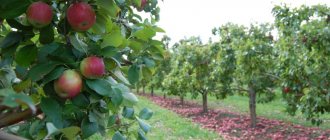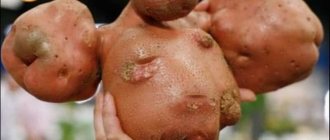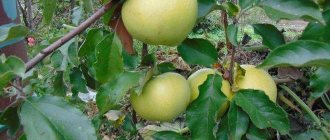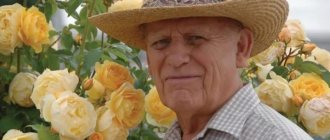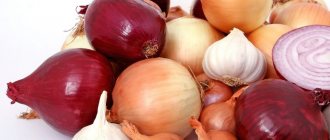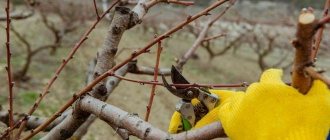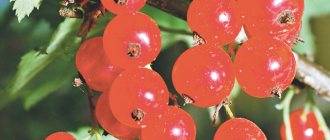Gardening » Apple tree
1
416
Article rating
Kira Stoletova
Most apple seedlings are the result of grafting. The rootstock for an apple tree is that part of the plant that is responsible for feeding the bud grafted onto it or a cutting from a fruit-bearing tree (scion). When cultivating a garden crop, the choice of a rootstock variety is of great importance, because The future productivity of the tree and its health depend on this.
Features of rootstocks for apple trees
What are scions and rootstocks for an apple tree?
In principle, seedlings from a biological point of view can also be rooted. However, in many cases, ungrafted trees do not have precocity, that is, they begin bearing fruit relatively late.
But when selecting rootstocks and scions, it is important to take into account and know the compatibility of graft components in scion-scion combinations. The fact is that it greatly affects the productivity, mechanical strength and durability of trees.
What is the rootstock of an apple tree?
The rootstock is like the foundation of a fruit tree ; it is also a plant onto which a bud or cutting from a cultivated variety is grafted.
IMPORTANT! The rootstock influences various qualities and properties of the above-ground part of the tree: growth vigor, early fruiting, winter hardiness, the number of flower buds laid, fruit set, productivity, regularity of fruiting and their appearance.
Rootstocks.
Rootstock – what else do you need to know?
So, you want to plant an apple tree in your summer cottage, the variety of which you really like. If you simply throw a seed into the ground, there is a high probability that the fruits of the new tree will be small, sour, or even unripe. But you want to get a harvest of those incredibly tasty apples! This is where vegetative propagation of your favorite variety comes in handy, as it will preserve all its properties.
Delicious varietal wild apples - it's real
So you take a cutting from a tree of a favorite variety, such as the sweet Golden Delicious, and graft it onto a more weather- and disease-resistant rootstock. As a result, you get a tree with the desired sweet and juicy fruits.
A rootstock is a plant (or part of it) onto the stem or root system of which a scion (a cutting or part thereof with a bud of a plant of the variety you need) is grafted. The rootstock plays a very important role: it provides adequate nutrition to the upper part of the plant, i.e. scion.
What types of rootstocks are there?
The effect on these qualities depends on the vigor of the rootstocks .
On this basis they are divided into:
- Vigorous,
- Medium height,
- Weak-growing.
The latter, in terms of their influence on the grafted variety, are semi-dwarf and dwarf .
In addition, according to the method of obtaining and growing, rootstocks are divided into:
- Seeds,
- Clonal or vegetative,
- Intercalary or intercalary.
Apple seed rootstocks are seedlings grown from the seeds of ordinary varieties . Naturally, their vigor as rootstocks is determined by the vigor of a particular variety.
Gradation of apple trees depending on growth vigor.
Most varieties that have sufficient winter hardiness of the above-ground and root systems to be used as rootstocks in the conditions of the Non-Chernozem Strip are vigorous .
For example, to obtain seedlings, seeds of Grushovka moscow, Antonovka vulgaris, Borovinka and some others are often used.
Apple clonal or vegetative rootstocks
This is the initial planting material obtained by vegetative propagation of plant forms and species used as rootstocks. Very often, low-growing hybrids of apple trees and other types of fruit trees are propagated vegetatively.
If you are wondering whether it is possible to root a branch of an apple tree rootstock, then this is exactly the case when you receive a new seedling . In some farms where there are greenhouses with installations that make it possible to produce artificial fog, they propagate rootstocks by green cuttings.
A feature of clonal rootstocks is their fibrous root system, consisting of adventitious roots.
They have their advantages and disadvantages.
The advantages over intercalary rootstocks are:
- Comparative uniformity of the resulting trees in terms of growth vigor and time of onset of fruiting;
- Possibility of planting in areas with close groundwater levels.
Disadvantages are also associated with the superficial location of the root system and manifest themselves:
- Less tree stability in the soil;
- More dependent on the regularity of rainfall or artificial irrigation, since the surface layer of soil dries out quickly during dry periods.
Intercalary or intercalary
They are a combination of a seed rootstock and an intermediate insert of a weak-growing rootstock or simply a standard-former.
It is a cutting (a piece of stem) cut from the mother plant, usually a low-growing form of apple tree (dusena or paradise) from 12 to 22 cm long.
The advantage of seedlings on such rootstocks is the combination of comparative short stature and early fruiting with good soil stability.
A possible disadvantage is the insufficient mechanical strength of some dwarf forms of apple trees, for example, Budagovsky's Paradise.
Apple rootstocks for the middle fruit growing zone
Apple rootstocks for the middle fruit growing zone
Among the global assortment of clonal rootstocks for apple trees, there are none that could grow freely in the central zone of our country. In harsh snowless winters they freeze out here. For this vast area of industrial fruit growing, new rootstocks bred at the Department of Fruit Growing of the Fruit and Vegetable Institute can now be recommended. I.V. Michurin is the author of this book. They still occupy an insufficient area (about 1000 hectares), but the first results of their assessment, obtained under production conditions, are positive.
Very dwarf. No. 195. Originated from crossing the Yuyulskoye variety with red-leaved paradise. The uterine bush is small, consists of shoots curved at the base with a well-defined camber. The color of the leaves and shoots is brown-red. Layers take root weakly. The varieties grafted onto No. 195 grow quite satisfactorily in the nursery.
The root system occupies a small volume of soil and lies superficially. Wood is brittle, which is why trees need support. Winter hardiness is good, the roots can tolerate a drop in soil temperature to -14-160 C. Grafted varieties in the garden have very dwarf growth, reaching 1 m in height at the age of 6 years. The fruiting season begins in the 2-3rd year.
Due to extremely weak growth, we believe that rootstock No. 195 is unpromising for production, but is interesting for amateur fruit growers.
Dwarf. Paradise red-leaved (No. 9). Obtained from crossing M VIII with the Michurin variety Red Standard, which has red pigmentation of the leaves. The uterine bush is medium-sized, wide-spreading, consists of thick shoots curved at the base with brittle wood. The color of the leaves and shoots is brown-red, the layering takes root satisfactorily (about the same as that of M IX), which inhibits its reproduction. The rootstocks take root well in the nursery. Seedlings grow much weaker than on vigorous rootstocks, but their yield per hectare is high.
The root system is highly branched, the bulk of it lies shallow, although some of the roots penetrate to a depth of 3 m in chernozem soils. This ensures good drought resistance of the plants. The wood is brittle, which is why trees often fall in strong winds or under the weight of crops. In industrial plantings, trees grafted on red-leaved paradise need support.
The winter hardiness of the root system is satisfactory, it can withstand a decrease in temperature to -13-140 C. In severe snowless winters, when the temperature in the soil drops below these limits, it can be damaged.
Varieties grafted onto red-leaved paradise have a dwarf (2 to 3 m) growth, are early-bearing (begin to bear fruit in the 3-4th year) and are very productive. Red-leaved paradise can be recommended as a rootstock in the middle zone, where the snow cover is stable. There are positive results when using it as an intermediate insert. As studies by the Institute of Horticulture in Poland have shown, red-leaved paradise turned out to be immune to the fungus that causes ring rot (fusarium), which kills trees grafted on East Malling and Malling Merton rootstocks.
For wide production testing, red-leaved paradise is recommended in all regions of the Central Black Earth and Central regions of the RSFSR, in the lower Volga region, and Belarus.
No. 257. The rootstock was obtained from free pollination of red-leaved paradise, grafted into the crown of a very winter-hardy rootstock No. 13-14. The uterine bush is wide-spreading, red-leaved, with runaway, sometimes highly twisted shoots. The cuttings take root satisfactorily, take root well in the nursery and provide a high yield of seedlings.
The root system is superficial, brittle, like other dwarf rootstocks. Winter hardiness is higher than that of red-leaved paradise. During the harsh snowless winter of 1968/69, no damage to the roots was observed. The growth of the trees in the garden is dwarf, the crown is half drooping. The varieties grafted onto No. 257 enter the fruiting season early (in the third year) and bear fruit abundantly.
The rootstock can be recommended for wide production testing in the central zone of the USSR.
No. 146. Obtained from free pollination of red-leaved paradise. The uterine bush is small, spreading, consisting of shortened shoots. Leaves and shoots with well-defined red pigmentation. The cuttings have brittle wood and take root well, forming a densely branched bunch of roots. The survival rate of cuttings in the nursery is high, but the yield of seedlings is reduced, since there is a breakdown of the rootstocks, usually near the ground.
The root system is superficial. Its winter hardiness is good, it can withstand temperatures down to -14-160 C. In the harsh snowless winter of 1968/69, the trees grafted on No. 146 were completely preserved. The varieties on this rootstock are characterized by high early fruiting, and many begin to bear fruit in the second year after planting. The fruits are large, with intense color, high taste, but their shelf life is somewhat reduced compared to varieties on medium-sized or vigorous rootstocks. Compatibility with grafted varieties is good.
Trees grafted on No. 146, due to the high fragility of the root system, require support, which should be installed in the year of planting. We do not recommend the rootstock for industrial fruit growing, but it is of interest to amateur fruit growers.
Semi-dwarf. 54-118. Obtained from crossing the red-leaved paradise, grafted on M III, with a winter-hardy new rootstock No. 13-14. The uterine bushes are powerful, almost cylindrical in shape, consisting of long, dense shoots without branching with slight bends along the internodes in the upper part. The rootstock belongs to the group of red-leaved forms. The cuttings root successfully, forming fibrous roots. The rootstocks in the nursery grow well even in dry years. The yield of seedlings is high.
The root system occupies a significant volume of soil, extending beyond the crown, is branched, and evenly saturates the soil horizons. Trees on this rootstock are firmly anchored in the ground, and no cases of tilting have been observed. Regrowth occurs rarely. The root system is winter-hardy and can withstand temperatures down to -160C. In the harsh snowless winter of 1968/69, when the roots of wild forest apple trees and seedlings of cultivated varieties froze in the orchards near the city of Michurinsk, no freezing was noted on this rootstock. Compatibility with all varieties of apple trees in the middle zone is good. The trees begin to bear fruit in the 4-5th year after planting; in the seventh year, 50 kg of fruit were harvested from Borovinka, which is about 200 centners per hectare; at Antonovka, the ribbing of the fruit increases slightly. Fruiting of the studied varieties is periodic, as on vigorous rootstocks.
Rootstock 54-118 is recommended for the middle fruit growing zone (Central Black Earth region, Volga region). It is also interesting to test it in the northern part of the southern fruit growing zone, where periodic frost damage to the root system of widespread clonal apple tree rootstocks is observed.
Medium height. 57-233. Originated from natural pollination of red-leaved paradise, which was grafted into the crown of rootstock No. 13-14.
The uterine bush is vigorous, erect, has powerful, smooth, well-rooted layers. Shoots and leaves with intense red pigmentation.
The cuttings are growing well in the nursery. You should not be late with budding, since their bark stops separating earlier than other rootstocks. The seedlings grow strongly and their yield is high.
The root system of trees grafted on 57-233 is powerful, well branched and occupies a large volume of soil. The stability of the trees in the garden is sufficient, and no cases of tilting were observed. It produces few shoots. Winter hardiness is high and can be equated to the winter hardiness of the Chinese apple tree. Compatibility with all standard varieties of the middle zone is normal.
The trees in the garden grow well, they begin to bear fruit in the 4th-5th year, and in later-fruiting varieties in the 6th-7th year. The rootstock is recommended as a medium-growing rootstock for the central zone of the USSR (Central Black Earth region and Volga region). It is advisable to test it as a winter-hardy form in other areas.
57-490. Brought out by crossing red-leaved paradise with No. 13-14. The uterine bush is medium-sized, consists of straight shoots without lateral branches, which take root very well when hilled. The color of the shoots and leaves is reddish, but less intense than that of 54-118 and 57-233.
The rootstocks in the nursery take root well and grow, but in dry years the bark stops separating early, which should be taken into account when organizing budding. The yield of seedlings in the nursery is high.
The trees in the garden grow quickly and in the first years differ little from vigorous trees, but with the onset of mass fruiting their growth weakens. The root system is powerful, occupies a large volume of soil, is very branched, with well-defined thick roots, which create reliable stability even for trees bearing a bountiful harvest. Does not form shoots.
The winter hardiness of 57-490 is high, the roots can withstand temperatures as low as -160 C, and even in severe snowless winters we did not observe any damage to them in the middle zone. Compatibility with all varieties of the middle zone, according to our observations, and many varieties of the southern zone, according to I.P. Berezhny, good.
Trees grafted on 57-490 begin to bear fruit 5-6 years after planting them in the garden, and late-fruiting varieties such as Orange - in the 7-8th year. The rootstock is recommended for fruit growing in the middle zone instead of vigorous rootstocks. According to preliminary tests, it showed itself on the positive side in some southern regions (Kazakhstan, Kyrgyzstan, Rostov region). According to Yu.L. Kudasov (Kazakh Research Institute of Horticulture), in terms of its ability for vegetative propagation, the rootstock took one of the first places among the extensive collection of clonal rootstocks of domestic and foreign origin.
T 273 (Timiryazevsky 273). Removed by B.A. Popov at NIZISNP. The bush is sparse, with a small number of shoots. Layers take root well. Not tested enough yet. Deserves production testing in areas of the Non-Chernozem Zone, where there is stable snow cover.
Apple tree varieties that reproduce vegetatively by shoots (Chulanovka, Mamutovskoe, Yandykovskoe, Kistyanka, Bel krupaya) did not give positive results when tested as rootstocks. In most of them, layerings on mother plantations root poorly. In addition, all of the listed varieties, except Chulanovka, are characterized by insufficient winter hardiness in the middle zone.
Pear rootstocks.
Of the weak-growing pear rootstocks, quince A and C can be recommended for industrial crops.
Quince A (Angers quince). The most common semi-dwarf pear rootstock in the southern regions of our country (southern Ukraine, Moldova, North Caucasus, Transcaucasia, rarely Central Asia). Quince bush A is dense, erect, and consists of long elastic shoots. On the mother plantation, quince A forms many shoots, which take root well when hilled. Lignified cuttings root by 60-70%.
The root system is finely branched and lies close to the surface. Pear trees grafted onto Quince A often bend over. This rootstock performs well in rich, moist soils.
Quince A is not winter-hardy. In connection with this, it can be used for industrial purposes where the soil temperature in winter does not fall below -8-90 C. Pear trees on Quince A, depending on the variety, live from 20 to 30 years, sometimes longer.
Quince C (dwarf quince). Dwarf rootstock for pear. The trees on it grow weaker than on Quince A. This rootstock has not become widespread in our country, although it is of interest for pear varieties that grow relatively strongly on Quince A.
Quince C bushes are smaller in size than quince A bushes, dense. On the mother plantation they have a weaker shoot production ability compared to Quince A; the cuttings take root quite satisfactorily. The root system is highly branched and shallow, which leads to trees falling in strong winds. Like Quince A, this rootstock requires well-filled and moist soils and does not tolerate excess carbonates. Grows better in slightly acidic than slightly alkaline soils.
Many pear varieties with quince C have poor compatibility and require intermediate grafting. The winter hardiness of the root system is low, even somewhat inferior to Quince A, so this rootstock can only be used in the southern regions, when there is a need to obtain truly dwarf pear plants.
Quince Provence is a semi-dwarf pear rootstock, somewhat superior in growth vigor to Quince A. It was brought to our country from France about 15 years ago to the Sochi region and some other quarantine nurseries. First observations showed that this quince is interesting for fruit growing, and therefore it has now begun to be widely propagated.
The uterine bush consists of a large number of shoots of fairly strong growth, without lateral branches, which take root well when hilled. In the nursery, layerings have a high survival rate. Like other types, Provençal quince is not compatible with many pear varieties. However, this symptom manifests itself less sharply than in quince A and C. With compatible varieties it ensures a high yield of high-quality seedlings.
The root system is highly branched, most of it lies superficially, but somewhat deeper than that of quince A and C. It forms a lot of shoots in the garden. Sometimes trees bend under the weight of the harvest. Winter hardiness is low, but there are indications that this trait is superior to quince A and C. Drought resistance is somewhat better than that of quince A and C.
Pear varieties compatible with Provencal quince begin to bear fruit in the 4th-6th year. Productivity is high, fruit quality is good. Provencal quince should be recommended for wide production testing in the southern regions, where the soil temperature does not fall below - 90 C in winter.
In addition to the listed rootstocks, in the southern regions of our country there are interesting local forms that reproduce well vegetatively and have a number of other positive properties. Noteworthy are the clones isolated in Modavia by G.A. Kabluchko, in Ukraine A.I. Kasyanenko, in Crimea A.F. Margolin, in the Volgograd region T. I. Gorin and others.
For the middle zone I.V. Michurin obtained hybrids by crossing wild mountain Caucasian quince with semi-dwarf quince from Sarepta. Of these, over three generations, he selected the most winter-hardy and drought-resistant plants. This is how the northern quince was obtained. Tests have shown that it reproduces poorly vegetatively, and in harsh, snowless winters its root system still freezes. In this regard, M.A. Kamenskaya at the Department of Fruit Growing of the Fruit and Vegetable Institute named after I.V. Michurina selected among northern quince seedlings more winter-hardy specimens capable of propagation by layering. But these forms turned out to be far from perfect. Work on creating the most promising low-growing pear rootstocks continues.
How to grow wild apple trees onto rootstock?
As a rule, in nurseries, wildflowers are obtained by growing from seeds , which occurs in several stages: extracting seeds, their stratification, sowing, caring for seedlings, picking seedlings, digging up seedlings, planting rootstocks.
Procurement of seeds. Depending on the scale of the farm and nursery, it can be either manual or mechanized.
In private nurseries it is done manually, and in nurseries of large farms the ripe fruits are crushed in fruit crushers.
Good to know! Seed stratification is the effect of low temperatures on them.
In areas with light, non-floating soils, seeds can be sown in the fall. Thus, they will undergo natural stratification.
If the soil in the nursery is heavy and floating, then artificial stratification in sand is recommended. To do this, the seeds should be mixed with 3 parts of wet coarse river sand and stored in boxes.
ADVICE! It is recommended to choose the following dimensions for boxes: 60 cm in length, 30-40 cm in width and 25 cm in height.
Single seeds can be stratified in a flower pot. It is recommended to store seeds mixed with sand in the basement at a temperature of +3-+5 degrees.
As the temperature in the basement rises, and even more so when signs of germination appear, the container with seeds should be placed on ice or buried in the snow before sowing.
It is recommended to stratify the seeds of an ordinary domestic apple tree for at least 90 days, for the Chinese apple tree (plum leaf tree) - from 70 days, for the Siberian berry apple tree - for at least 30 days.
Seeds should be sown in beds with fertilized and treated soil after the soil has physically ripened. It is recommended to plant apple tree seeds to a depth of 2-3 cm, sowing them in the furrows along with sand.
After sowing, it is recommended to mulch and water the soil surface. seedlings during the period from the beginning of the cotyledons to 2 true leaves. In this case, it is recommended to pinch the central root, leaving it 4 cm long from the root collar.
to plant the seedlings according to the scheme 15-20 x 7-8 cm. After planting, the seedlings must be watered, mulched and shaded for the first days.
Seedling care
In summer, seedlings are recommended to weed and loosen the soil under them.
In the first half of summer, it is advisable to fertilize:
- Infusion of manure;
- Or a solution of ammonium nitrate (at the rate of 40 g per 10 l);
- Or urea, using ¼ bucket per 1 linear meter of row.
Growing seed stocks in a container
This method of obtaining rootstocks involves stratifying apple seeds in a cool basement or refrigerator. It is necessary to plant seeds with the expectation that they will open by mid-March. To do this, within three to four months, all the seed material is mixed with moistened sand and placed in a cold place.
The hatched apple tree seeds are planted in previously prepared soil. To prepare this mixture you will need the following ingredients:
- Decomposed peat – 1 part;
- Garden soil – 1 part;
- River washed sand – 1 part.
To this composition, per 10 kilograms, add 1 glass of wood ash, and 25 grams of potassium salt and superphosphate.
The resulting mixture is filled with peat-humus pots, which can be purchased at specialized garden stores. In addition, you can use regular milk cartons, plastic cups or plastic bags as containers. The size of the container for apple seedlings should not be less than 6x6x6 centimeters. In this case, it is necessary to provide holes at the bottom to drain excess water.
In each cup prepared in this way, hatched seeds are planted, grown for apple tree rootstocks. The optimal quantity for one glass is two seedlings. This is dictated by the considerations that one of the two sprouts will necessarily be stronger than the other. It is this that is then left for further cultivation.
Compatibility of apple tree rootstocks and scions
The best compatibility was observed in most varieties with seedlings of Antonovka, Grushovka, Borovinka.
At the same time, there is poor compatibility of many apple varieties with china and purpurea seedlings.
So, for example, the following varieties are considered incompatible with Chinese as a rootstock :
- Anises,
- Antonovka vulgaris,
- Babushkino,
- Borovinka,
- Korobovka and many others.
In this case, the following varieties can be considered compatible :
- Velvet,
- Cinnamon new,
- Pepin saffron
- some others.
In most cases, insufficient compatibility manifests itself in starvation and subsequent death of the root system .
In addition, insufficient compatibility is manifested in apple tree varieties with other pome-bearing species : serviceberry, hawthorn.
In this case, reduced compatibility is expressed in the relatively short life span of such scion-rootstock combinations.
Place of grafting when planting an apple tree
The position of the grafting site when planting an apple tree is of particular importance for seedlings on weak-growing rootstocks, since in order to preserve weak growth and early fruiting, it is important to plant the tree so that the vigorous scion does not touch the ground .
Otherwise, it may take root and the influence of the weak-growing rootstock will be greatly weakened. Here it is worth paying attention to the features of planting seedlings on clonal and intercalary rootstocks .
For example, when planting apple trees on clonal rootstocks, the grafting site should be approximately 3 cm above the level of the site.
But when planting seedlings with inserts, the position of the grafting sites depends on the climate of your area.
Proper planting of an apple tree.
Particularly in areas with sufficient snowfall, the insert can be left above the soil surface. However, if winters in your area have little snow, then 1/3 to 2/3 of the insert should be buried in the ground.
The root shoot of an apple tree is like a rootstock. Mature apple trees grafted onto seed and intercalary rootstocks often produce root shoots. Most of it, of course, should be cut out.
However, some stems growing at a distance of 15 cm or further can be used for grafting . So, at a height of approximately 10-25 cm from the ground, you can vaccinate using copulation in the spring or budding in the summer.
ADVICE! If the grafting takes root, then in the fall the grafted tree can be transplanted to a convenient place.
Growing clonal rootstocks
Everything is much simpler here. All you need to do is purchase a ready-made rootstock and cut off its top. Planting the apple tree rootstock should be done in the queen cell, where it will give you new shoots for 10 years. It is for this period that this site must be reserved in advance. Heavy, clayey soils are completely unsuitable for mother plants, but sandy soils, on the contrary, will be an ideal option, but only under the condition of constant watering. Keep in mind that, together with the rootstocks, you will take a colossal amount of nutrients from the soil, due to which the soil in the queen cell is very quickly depleted. Therefore, regularly apply mineral fertilizers, sawdust and straw, and rotted manure. Here someone will begin to argue that sawdust acidifies the soil, but the apple tree tolerates such conditions well.
How many rootstocks you need, decide for yourself based on your own needs. If you need a large queen cell, then keep the distance between the rows about 150 cm. You will not have a tree growing, but a bush. Before planting, we dig a small ditch, about 8 cm, and plant the rootstock in it at the required distance. Immediately after planting, we cut it at a height of 30 cm. The first year the plant’s task is to take root well, so no additional manipulations are required. Early in spring, next year, cut the stump 5-7 cm high from ground level. Shoots will begin to grow from the spare buds, and as soon as they reach a height of 15 cm, they will need to be sprinkled with earth. As it grows, you need to hill up the mother plant at least two more times. Be sure to moisten the soil before doing this or hill up after rain. In the fall, you can take away the finished cuttings and plant them separately. After this, it is necessary to cover the bare parts of the mother liquor with soil. In the spring, you should not delay opening the bushes covered in autumn, so as not to delay the awakening of dormant buds. In this way, your garden can be constantly supplied with practically free material for growing varietal apple trees. If you have a large territory, then this activity can be the start of a profitable business.
How to determine which rootstock an apple tree is on?
In a grafted apple tree, only the type of rootstock can be determined.
For example, in a seed rootstock the root system consists of part of the taproot and five thick roots extending from it.
The clonal rootstock has a fibrous root system.
That is, it represents a large number of roots coming from the trunk.
Seed and clonal rootstock.
In terms of rootstock shape, one can usually determine the origin of a particular rootstock shape, but one must be a rootstock specialist to do this.
Features of different varieties of apple trees as rootstocks
Niedzvetsky apple tree
This type of apple tree has become widespread only in Central Asia and Kazakhstan. In central Russia it freezes out.
Chinese
This type of apple tree is considered winter-hardy, drought-resistant, and also resistant to fungal diseases. Can be used in landscaping. It is often considered as a rootstock, but it is compatible only with certain varieties, for example, Melba, Autumn Striped, Renet Krudner and some others.
At the same time, it is poorly compatible with Anise, Antonovka vulgaris, Borovinka and many other varieties. Therefore, if you use it at all as a rootstock, then with great caution, having first studied its compatibility with the propagated varieties.
Siberian berry apple tree
This species has various forms from medium-growing, reaching a height of 3-4 m, to vigorous-growing with a height of 10 m. It has become widespread as a rootstock in Siberia and the Urals.
In Siberia, they grow well as a rootstock:
- Antonovka saffron,
- Borovinka,
- Autumn striped,
- Padding.
The roots of this apple tree are distinguished by good winter hardiness, but low drought resistance.
Propagated by both seeds and root cuttings.
It is recommended to bud seedlings of this species earlier than other rootstocks, since it ends the growing season earlier.
Apple tree purple
This species was obtained by crossing the Niedzwiecki apple tree with a dark red apple tree.
Winter hardiness is slightly higher than that of the Nedzvetsky apple tree, thanks to this it has become widespread in the southern and central and central black earth zones of Russia.
Can withstand frosts down to -34 degrees . However, the degree of compatibility with domestic apple varieties is unknown.
Apple tree Raika
From a botanical point of view, rajka is a paradise apple tree or a bushy apple tree, called paradiska by fruit growers. The common people often confuse it with the Chinese one; in fact, they are different species.
A relatively common dwarf rootstock for apple trees , widely used in rootstock selection and used on an industrial scale. This type includes the best dwarf rootstocks M-IX, 62-396, 57-366, 57-491 and apple tree rootstocks 54 118.
Non-standard rootstocks
Rowan
Sometimes used by gardeners for lack of a more suitable rootstock. However, such a tree is usually short-lived due to the large difference in the rate of growth in thickness between the apple tree and the mountain ash.
Hawthorn
Some gardeners use hawthorn as a dwarf rootstock for apple trees. True, they recommend grafting an apple tree onto it at a height of 50-60 cm.
On the one hand, experience shows that as a rootstock, hawthorn can accelerate the entry of an apple tree into fruiting by a year. On the other hand, there are cases where apple trees on other species were only able to live for about 8 years.
CONCLUSION! Therefore, using hawthorn as a rootstock is not practical from a production point of view.
And if you are wondering how an apple tree will grow and develop on a hawthorn, then in the author’s opinion such a tree can only be grown as an exotic tree on a personal plot.
Irga
Irgu can be considered an unpretentious breed, perfectly adapted to the natural conditions of the non-chernozem zone. An apple tree can take root on serviceberry , however, in some cases, the apple tree as a scion may be thicker than the serviceberry rootstock, which can contribute to the fracture of the tree.
Compatibility of scion and rootstock.
What types of rootstock are there?
There are two types in total:
- Seeds;
- Vegetative.
Useful properties and contraindications of hawthorn
The vigorous type refers to the seed type. Apple trees with it will grow up to seven meters, but will begin to bear fruit late. Such a tree will be strong, durable and highly productive. But, since the speed of fruit production is of paramount importance for farmers, this type is not popular in gardening due to late fruiting.
Dwarf rootstock is a type of vegetative propagation. It is the most popular. An apple tree with such a foundation will grow no higher than 2 meters. It will not be resistant to frost, have a strong root system, or be unpretentious to weather and soil. The main feature of this type of propagation is rapid fruiting, which usually occurs in 2 or 3 years. However, in cold areas of the country this type of plant will require special care.
The semi-dwarf type for an apple tree also belongs to the vegetative type. Such trees are characterized by average durability, growing up to 4 meters and bearing fruit already 4 years after grafting. An apple tree with such a base will be unpretentious to the soil and conditions.
Apple tree planting scheme
Distances in rows and row spacing should be left taking into account the growth vigor of the variety and rootstock, as well as the type of seedling. In addition, planting patterns may vary in different climate zones.
For example, in the non-chernozem zone:
- It is recommended to plant vigorous trees on seed rootstocks according to a 6x4 m pattern,
- On intercalary rootstocks 5x3 m,
- On clonal ones 4-5x2-3 m.
In the southern zones of Russia, it is recommended to leave 1-2 meters between trees on dwarf rootstocks in a row.
The scheme for planting apple trees on a mm 106 rootstock recommends planting them according to a pattern of 4.6 x 1-1.5 m. That is, with row spacing of 4.6 m and with distances between trees in a row from 1 to 1.5 m.
Proper planting and embedment depth. If you did the grafting yourself, then the planting rules will depend on how deep your groundwater is. When standing close, it is recommended to sit on a mound.
Useful videos:
Watch a video about proper planning of an apple orchard:
Watch the video for professional advice on planting apple trees:
For normal planting, it is recommended to prepare a hole for planting with a width of 50 to 80 cm and a depth of 50-60 cm, depending on the texture of the soil and the size of the root system of the seedling.
In this case, the root collar should be at a height of 5 cm above the ground level on the site. Accordingly, the grafting site should also be above the ground.
How to prepare apple tree scions?
To cut cuttings you should know some rules:
- As a mother tree (or trees), you should choose those that have been tested for variety and productivity;
- For cuttings, you should choose mature annual stems (shoots);
- They must be selected from the outer part of the crown, preferably facing south;
- It is better to cut the stems from the shoots of the middle tier;
- It is better to cut the stems in the second half of November or early December, the main thing is that they do not show signs of freezing;
- It is better to make cuttings from powerful growths , the length of which is 40 cm or more, and the thickness is close to that of a pencil.
Storage principles should be determined by the weather and climatic conditions of your area.
For example, in areas and regions where a lot of snow falls, it is recommended to store the stems in snow piles under a layer of snow of 50-70 cm.
If there is little snow in your area or little of it has fallen by the time the scions are harvested, then the cuttings can be stored for a short time in the lower compartment of a regular refrigerator.
In this case, it is recommended to cut the harvested shoots into 30 cm pieces and put them in a plastic bag, placing them with damp peat, moss or sand, then seal the bag hermetically.
IMPORTANT! In this case, the internal temperature of the refrigerator should, if possible, be 1-2 °C.
At other temperatures, long-term storage of cuttings is impossible. In addition, cuttings should be frequently checked for the possible appearance of swollen buds (the danger of premature awakening) and mold damage.
Watch the video for important information on how to prepare cuttings for further grafting:
Columnar apple trees
They are a separate crop of apple trees with a very compact crown. Trees with small crowns. They take up little space and therefore have become of considerable interest.
Important aspects of caring for columnar apple trees to obtain an excellent harvest.
The following varieties are known as columnar varieties:
- Vasyugan,
- Dialogue,
- Malyukha,
- Arbat,
- The president,
- Nectar.
The last 3 varieties are most widespread in the Non-Chernozem zone.
Below are their characteristics:
- Nectar. This is a summer variety with early fruiting. The trees can withstand frosts down to -42 degrees. The weight of the fruit varies from 100 to 140 grams. They taste sweet with a honey aroma. Maturity occurs towards the end of August.
- The president. Early winter variety . The fruits taste sweet and sour, dessert, and weigh up to 250 grams. Productivity 5-6 kg per tree. Fruit maturity occurs in mid-September, and the shelf life is 1.5 months.
Growing methods
To grow high-quality and healthy apple trees, seeds and branches must be taken from 1-2-year-old trees that have survived the winter without cracking the bark and are not affected by various pests.
It is advisable to prepare a donor tree 2-3 months before taking seedling material.
Regular watering is required at the rate of 10 liters per one-year seedling, fertilizing with complex fertilizers or applying rotted compost with digging up the soil near the trunk area.
From seeds
To ensure high survival rate, it is recommended to germinate seeds of the same type as the grafted variety.
For generative propagation, wild trees with a main trunk diameter thicker than 3 cm are used.
Stronger seedlings come from immune varieties resistant to diseases: Solnyshko, Antonovka, Rozhdestvenskoye, Kandil Orlovsky.
Seeds are taken from a healthy frost-resistant apple tree - this way the offspring quickly adapt to the local climate.
Correct germination technology:
- At the end of September and October, remove the seeds from the seed pods of a ripe apple and place them on a dry surface. Dry for 6-7 days, rinse off the apple juice first.
- Soak for 2 days, replacing the water with new water daily. Place the container in a bright place, avoiding direct sunlight. On the 3rd day, add 1 drop of Epin or 0.25 g of sodium humate to 50 ml of water, let stand for 7-8 hours.
- After swelling, the seeds are laid out on a slightly damp cotton rag, wrapped, and placed in a plastic bag. Ventilation must be maintained - it cannot be hermetically sealed.
- Stratification occurs at 0 7 °C. The germinated material remains on the bottom shelf of the refrigerator for a month. As the fabric dries, it is necessary to slightly moisten it.
- Remove the seeds, unwrap them and keep them at room temperature, soaked in warm water. After 2-3 days, sprouts appear.
In the second half of March, they can be planted in mini-greenhouses with coconut substrate, purchased hydrophilic soil mixture or soil taken from the area where the seedlings are planned to grow continuously.
The seeds are deepened at a distance of 4-5 cm, with a depth of no more than 2 cm. It is convenient to water in a tray - spraying with a spray bottle creates a crust on the surface of the soil.
After 2.5-3 weeks, the seedlings have 4 full-fledged leaves. If there is not enough space in the greenhouse for free growth of roots, apple trees are planted individually in larger pots. Before planting in a permanent place, it is recommended to replant sprouted apple trees 3-4 times.
The soil must be prepared for planting
The tactic stimulates productivity, increases the tree’s immunity, seedlings become resistant to damage to the bark by pathogenic organisms, and have developed fibrous roots. Selection is carried out with dwarf varieties - plants obtained from seeds are characterized by increased vegetation.
It is not advisable to add fertilizer of natural origin in the first year; fragile roots can get chemical burns.
To improve the condition of the wood, in the 2nd year a phosphorus-potassium mixture is used: 15 g of potassium chloride mixed with 30 g of superphosphate. Fertilizer is applied at the end of August, and then each apple tree is watered abundantly.
The quality of seed material increases noticeably in a good year.
Cuttings
The vegetative clonal one must be taken from the mother plant, which guarantees a genetically identical tree, increases productivity, and frost resistance.
Fruiting occurs earlier - the seedlings are pre-adapted to local climatic conditions and the chemical composition of the soil.
It is better to prepare apple tree branches 2 weeks before frost, when sap flow and vegetation have stopped.
One-year woody shoots with 3 living buds are collected. You need to cut it early in the morning - before noon, the wood and cambium contain more nutrients and moisture.
Growing technique:
- Select ringed, fruit-bearing branches, 7 mm wide and 25-30 cm long. Trim with a sharp, disinfected tool, remove the remaining foliage.
- Place the branches in a ventilated container with moss and damp sand. Store at approximately 3-4 °C. Make sure that the wood does not dry out; spray it weekly with water or a weak infusion of chamomile.
- In the spring, cuttings are taken out and kept in a growth stimulator for 5-6 hours.
- They are buried 2-3 cm in a moist mixture of vermiculite, high peat, perlite and river sand, mixed in a ratio of 1:1:1:1:1. The optimal distance is 10-15 cm. The greenhouse container must have drainage holes.
- In order for roots to appear faster, overcooling of the soil, drafts, and drying out of the earthen coma should be avoided. Weekly ventilation lasts up to 20 minutes.
The container with seedlings is placed in a lighted area, sheltered from direct sunlight. After 1-1.5 months, the first roots appear, air baths gradually become long-lasting, daily.
What is a rootstock and how to grow it?
Apple tree rootstocks. Vigor of apple trees on various rootstocks.
How to grow clonal rootstock. Part 1 - landing
The greenhouse is dismantled after swelling and bud opening. The soil must be carefully loosened and mulched with small sawdust and peat. They can be planted in open ground in mid-September, and the seedlings are ready for planting in a permanent place in 2-3 years.
To avoid the ingress of mold and bacteria, the sandy substrate is calcined in advance in an oven.
How to graft scions?
Grafting of varietal material onto rootstocks can be carried out using different methods.
grafting with cuttings is usually recommended :
- copulation,
- Grafting into cleft
- Vaccination for the bark.
Copulation is recommended in cases where the diameters of the rootstock and scion are the same or close. To carry it out, oblique cuts about 2-3 cm long are made on the rootstock and scion.
The method has two options: simple and improved.
In simple copulation, the scion cutting is simply applied with a regular cut to the cut on the rootstock. Improved copulation involves an incision on the cutting surface in the form of a tongue .
After combining the rootstock and scion, the grafting site should be covered with varnish and tied with film; polyvinyl chloride is best suited for this; sometimes it is possible to graft with electrical tape, as well as with modern films Rostok and Svetlitsa.
ADVICE! Spring grafting with cuttings should be done before buds bloom on the scion.
Watch the video for useful tips from experienced gardeners on how to properly vaccinate:
Grafting behind the bark and into the cleft are recommended in cases where the diameter of the rootstock is greater than the diameter of the grafted cuttings.
To graft behind the bark in the bark of the rootstock, you need to make a cut with a length corresponding to the cuts on the rootstock, about 2-3 cm, and on the scion cuttings you need to make the same cut as when copulating and insert it into the cut in the bark on the rootstock.
After this, cover the wound with varnish and wrap it with washcloth or PVC film . When grafting into a cleft, a cut is made across the cut on the rootstock into which a scion cutting, sharpened by a wedge, is inserted. After this, the grafting site is also covered and wrapped.
How to grow rootstocks?
Weakly growing rootstocks , both apple trees on dwarf rootstocks and semi-dwarf ones, are often propagated by layering, less often by cuttings, for example, lignified ones.
For most rootstocks, the yield of seedlings is greater when propagated by layering.
However, for rootstock 54-118 the rooting rate of woody cuttings is higher than for other rootstocks.
Rooting ability of apple tree rootstocks.
Let's consider ways to obtain and propagate low-growing rootstocks , including 54-118, M106 and others:
- To obtain vertical layering, you must first grow a mother bush. For this purpose, two-year-old seedlings must be planted in an area with deeply cultivated soil . Before frost begins, trees must be covered with sawdust, peat, or earth.
- In the spring of next year, the base of the mother plant must be carefully freed from the soil and the above-ground part must be cut off so that the upper part of the stump is 3-4 cm below the top soil level.
- Soon shoots will appear , which will need to be hilled up and watered. At the end of September, the rooted shoots must be unrooted and cut off from the mother plant.
Fruiting dates
The beginning of fruiting of apple trees depends both on the early fruiting of the variety itself and on the vigor of the rootstock. For example, some varieties begin to bear fruit relatively early, others quite late.
Relatively fast-growing varieties include Narodnoe, Welsey, Goldspur, Studencheskoe and others. At the same time, many old varieties on ordinary vigorous seed rootstocks begin to bear fruit in 6-8 years (Antonovka) and later.
On weak-growing rootstocks, the same varieties can begin to bear fruit 2-3 years earlier.
How to care for a grafted apple tree
Care procedures for a grafted tree are determined by analyzing the growth rates of the trunk and crown. For example, if the length of the branches is more than 40 cm, you can begin to form the crown. And in the coming spring it is advisable to reduce the main conductor by 2-3 eyes. Then you need to shorten and bend the skeletal branches so that they are below the trunk.
Growing grafted material: 1 - tying the oculant to the thorn; 2 - pruning of an annual seedling to the crown (on the left - unbranched, on the right - branched); 3 - tiered crown of a two-year-old seedling; 4 - sparsely tiered crown; 5 - pulling vertically located branches at the beginning of growth with a cord; 6 - the same as in 5, only with a copper wire device
